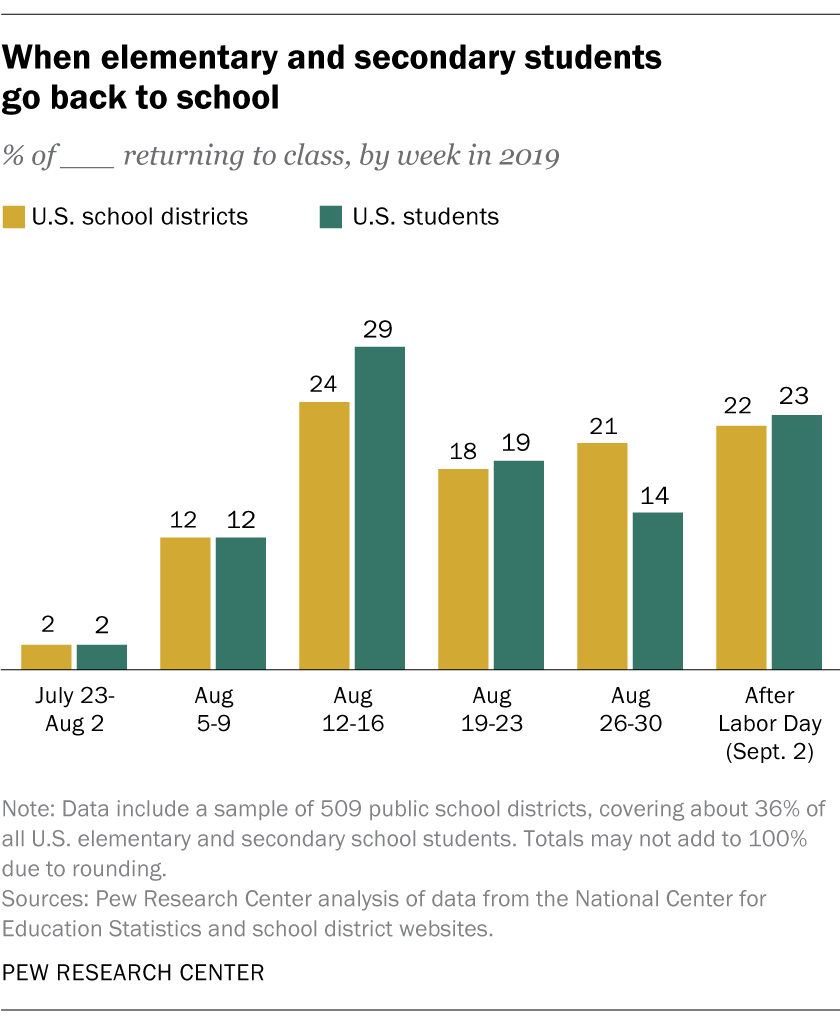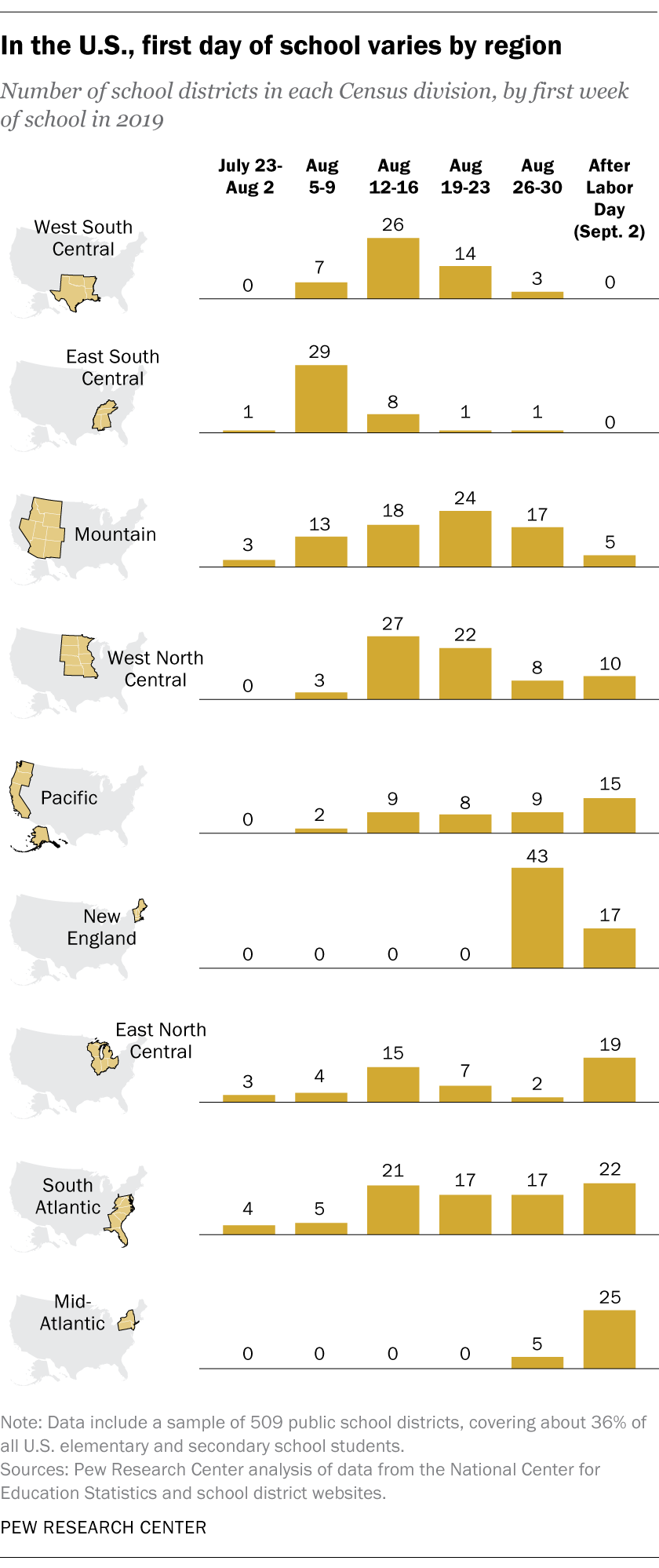In Three Weeks Time We Have to Begin School Again

It's the second full week of Baronial, which means millions of American schoolkids are heading back to school or have already started. And depending on where you alive, that statement might produce a reaction of either "That sounds about correct" or "That seems mode too early on!"
 Dorsum-to-schoolhouse dates in the Usa, it turns out, vary considerably by land and region, based on our assay of a sampling of the nation's thirteen,000-plus public school districts. Past the finish of this week, for example, nearly all elementary and secondary school students in the Due east Southward Central region – a Census Bureau division that includes Alabama, Kentucky, Mississippi and Tennessee – will be back in school. But not a single district in the nine New England and Eye Atlantic states will resume classes before Aug. 26, and many look until subsequently Labor Day.
Dorsum-to-schoolhouse dates in the Usa, it turns out, vary considerably by land and region, based on our assay of a sampling of the nation's thirteen,000-plus public school districts. Past the finish of this week, for example, nearly all elementary and secondary school students in the Due east Southward Central region – a Census Bureau division that includes Alabama, Kentucky, Mississippi and Tennessee – will be back in school. But not a single district in the nine New England and Eye Atlantic states will resume classes before Aug. 26, and many look until subsequently Labor Day.
The prize for the earliest starting time date among the 500-plus districts in our sample goes to Arizona's Chandler Unified Schoolhouse District, which serves part of suburban Phoenix. The 44,000 or so students in Chandler Unified went back July 23 (though they get the offset of three 2-week "intersession" breaks starting Sept. thirty). At the other extreme are the Trenton, New Jersey public schools, whose nigh fourteen,000 students won't get dorsum to school till Sept. nine – the latest opening engagement in our sample.

Broadly speaking, before starts are more common in the S and Southwest: In a rough band of 13 states stretching from Arizona to Florida and up to S Carolina, 79% of the districts we examined volition exist back in school by the finish of this calendar week. Later starts are more mutual along the East Coast (from Maine to North Carolina), the upper Midwest (Wisconsin, Minnesota, Michigan) and the Northwest (Oregon and Washington).
Historically, the tourism and hospitality industries have favored later back-to-school dates, arguing that they give families more time to accept vacations and teenagers more time to work summer jobs. For case, since 1986 Virginia'southward "Kings Dominion law" (named for the entertainment park just northward of Richmond) barred nearly schools in that state from opening earlier Labor Twenty-four hours. Earlier this year, the law was amended to permit districts to open to 2 weeks before, so long equally they as well give students a 4-mean solar day Labor 24-hour interval weekend. Still, six of the x Virginia districts in our sample are starting their 2019-20 school years after Labor Day; ii volition open Aug. 26, ane on Aug. 22, and ane (subject to a special provision) on Aug. 12.
To become a sense of when students head dorsum to schoolhouse, we looked at the 10 largest local school districts by enrollment in each state (except for Hawaii and the District of Columbia, which have only one district apiece). Nosotros also examined additional districts in Texas, Florida and California, and so that the last 509-district sample would include the nation'due south 100 biggest districts. We excluded private and parochial schools, public charter schools, state-run schools and other educational institutions that often operate on their own schedules. Our final sample covered almost 36% of the nation's 50.6 one thousand thousand public elementary and secondary students.
For each district in the sample, we adamant the date or dates on which most of their first-through-12th graders started fall classes. (Kindergartners often offset school after than their older peers.) Although a handful of districts are on some grade of twelvemonth-round schedule, and many others have individual schools that operate twelvemonth-round, we focused on the "traditional" calendars followed past most schools in a given commune. When start dates were staggered by schoolhouse or grade level, we used a date range.
All told, 124 of the districts in our sample (representing 29% of students) are starting school between Aug. 12 and Aug. 16, making information technology the most popular start week. Another 74 districts (with fourteen% of students) went back earlier this summer; 93 (19% of students) will start up once again next week.
But 105 districts (14% of students) won't start until the last calendar week of August – and nearly half of these (48) are in New England or the Center Atlantic states (New York, New Jersey and Pennsylvania). An additional 113 districts (with 23% of students) won't resume classes till after Labor Day, all only 22 of which are north of the Mason-Dixon line. (The 22 exceptions are in nearby Delaware, Maryland and Virginia.)
Are students going back to school before than they used to? Finding schoolhouse calendars from years and decades past for our sample districts proved to be beyond the reach of this assay, but at that place'due south some evidence that more secondary-school students, at least, are spending part of their summers in the classroom.
A divide Pew Research Center analysis institute that U.S. teens are spending more of their summer hours on educational activities – and less fourth dimension on leisure – than they used to.
Source: https://www.pewresearch.org/fact-tank/2019/08/14/back-to-school-dates-u-s/
0 Response to "In Three Weeks Time We Have to Begin School Again"
Post a Comment